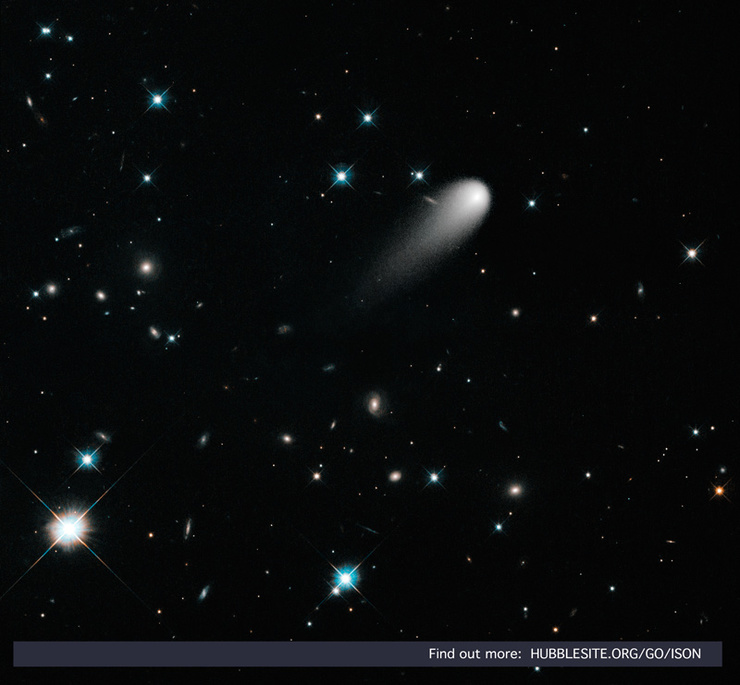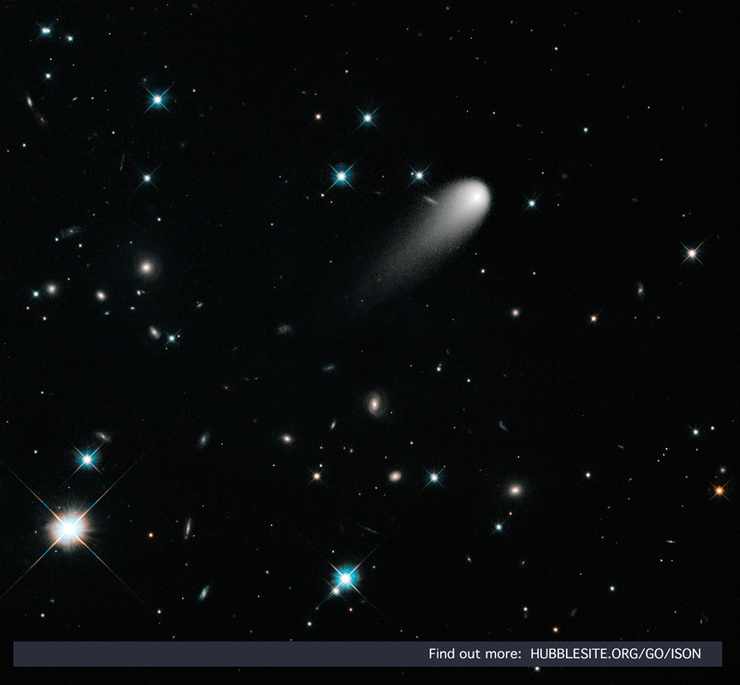Hubble releases new stunning image of comet ISON

Enhanced image of comet C/2012 S1 ISON obtained by Hubble Space Telescope on April 30, 2013 have been released yesterday, showing the comet zooming through deep space in all its glory.
 Hubble Space Telescope views Comet ISON, April 30, 2013 (Credit: Hubble\NASA)
Hubble Space Telescope views Comet ISON, April 30, 2013 (Credit: Hubble\NASA)
The image was created from a series of observations of comet ISON earlier this year, where the telescope focused on the comet and was set to capture faint objects like far away galaxies and stars in other. The result of combining those observations are these stunning image of ISON made by experts at NASA.
The result is part science, part art. It’s a simulation of what our eyes, with their ability to dynamically adjust to brighter and fainter objects, would see if we could look up at the heavens with the resolution of Hubble. The result is a hodgepodge of almost all the meat-and-potatoes subjects of astronomy – no glow-in-the-dark stickers required.
said Josh Sokol of HubbleSite ISONblog
Momentarily ISON is flying through deep space at a speed of roughly 77 000 km/h and will make its closest approach to the Sun on November 28, 2013 passing only 1 175 000 kilometers from the Sun`s surface.
.jpg)
Four stacked images of Comet ISON. Since Hubble followed the background, the comet
shifts position from exposure to exposure. To make the final image, we then shifted these
independent images of ISON into one combined Franken-comet. (Credit: Hubble/NASA)
Current predictions say that ISON will pass the so called "frost line", roughly 230 to 280 million miles away from the sun, by the end of July or early August, 2013. At that time the comet will experience enough radiation from the sun for the water inside it to start to evaporate. That process will make the comet brighten. However it is worth noting that some comets broke after passing the frost line.(Hubblesite,NASA)
.jpg)
Predicted hour-by-hour position of Comet ISON in various instruments on one of NASA’s Solar Terrestrial Relations Observatory spacecraft between 1 a.m. EST on Nov. 26, 2013, and 7 p.m. EST on Nov. 29, 2013. The blue field of view is from the outer coronagraph and green from the inner coronagraph.(Credit: NASA/STEREO/Goddard Space Flight Center)
Hopefully comet ISON won`t break apart when it passes the frost line, nor when it swings round the Sun, rather it will put a great show for sky watchers around the planet, possibly reaching naked eye visibility later this year.
Featured image: Hubble Space Telescope views Comet ISON, April 30, 2013 (Credit: Hubble\NASA)

Commenting rules and guidelines
We value the thoughts and opinions of our readers and welcome healthy discussions on our website. In order to maintain a respectful and positive community, we ask that all commenters follow these rules:
We reserve the right to remove any comments that violate these rules. By commenting on our website, you agree to abide by these guidelines. Thank you for helping to create a positive and welcoming environment for all.